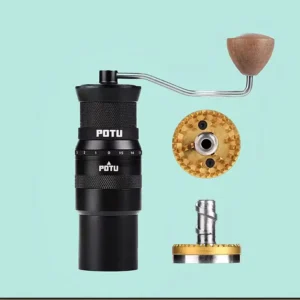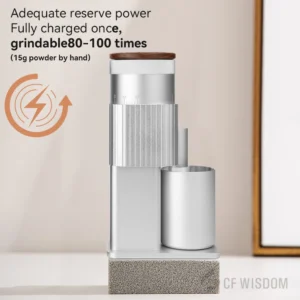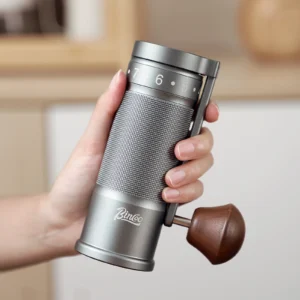Introduction: Why Fresh Ground Coffee Matters Even When Traveling
The difference between a mediocre cup of coffee and an exceptional one often comes down to one simple factor: freshly ground beans. Once coffee is ground, it begins losing its essential oils and aromatic compounds within just 15 minutes, significantly diminishing the flavor complexity that makes coffee so enjoyable.
For travelers, this presents a unique challenge. Limited luggage space, unpredictable accommodations, and inconsistent access to power can make maintaining your coffee ritual difficult. Hotel room coffee packets and convenient café stops might seem like reasonable alternatives, but they often fall short for those who truly appreciate quality coffee.
This is where a dedicated travel coffee grinder becomes invaluable. By bringing along a compact grinder, you maintain control over one of the most crucial elements of coffee preparation, ensuring that every cup meets your standards, regardless of where your adventures take you.
In this comprehensive guide, we’ll explore the essential features that make a coffee grinder truly travel-friendly, helping you understand how to select a portable companion that balances performance with practicality. From size considerations to grinding mechanisms, we’ll cover everything you need to know about travel-friendly coffee grinding options that won’t compromise your coffee experience.
What Makes a Coffee Grinder “Travel-Friendly”: Core Requirements
A truly travel-friendly coffee grinder goes beyond simply being small. It represents a thoughtful balance between portability and performance—a harmony of design elements that cater specifically to mobile coffee enthusiasts.
The ideal travel grinder should combine:
- Compactness without sacrificing grinding capability
- Durability to withstand transportation stresses
- Ease of use in varied environments
- Consistent performance regardless of location
Different travel scenarios demand different priorities. Backpackers counting every ounce might prioritize ultra-lightweight design, while business travelers might value quick operation and minimal noise. Road trippers might have more flexibility with size but need something that performs consistently across changing altitudes and climates.
Understanding this balance requires acknowledging that while some compromise may be necessary compared to your home setup, modern manual coffee grinders for travel have evolved to deliver impressive results in smaller packages. The best travel grinders maintain the essential qualities that affect cup quality while eliminating bulk and unnecessary features.
Essential Features to Look for in a Travel Coffee Grinder
Portability: The Perfect Travel Companion
The primary appeal of a travel grinder lies in its portability—how easily it integrates into your travel gear without becoming a burden. Ideal dimensions typically range between 6-9 inches in height and 2-3 inches in diameter, allowing the grinder to fit into side pockets, cup holders, or even coat pockets.
Weight is equally crucial, with the sweet spot for quality travel grinders falling between 5-12 ounces (140-340g). This represents enough heft for stability during grinding while remaining light enough for practical portability.
The shape of your grinder affects its packability significantly:
- Cylindrical designs often slide neatly into backpack water bottle pockets
- Boxy designs may stack more efficiently with other rectangular items
- Foldable handles reduce the overall footprint when packed
- Removable cranks provide maximum space efficiency
For those embarking on extended outdoor adventures, compact coffee grinders for backpackers offer specialized designs that prioritize minimal weight and maximum durability without compromising grinding capability. Some innovative models even integrate protective elements directly into the design, eliminating the need for additional storage cases.
Durability: Built to Withstand Your Adventures
Travel environments subject your equipment to stresses rarely encountered at home. Your grinder might be dropped on hotel bathroom tiles, compressed by overstuffed luggage, or exposed to humidity and temperature fluctuations that test its construction.
Material selection plays a critical role in durability:
Stainless Steel: Offers excellent impact resistance, doesn’t impart flavors, and resists corrosion—ideal for humid environments and long-term durability. Stainless steel manual coffee grinders typically represent the gold standard for travel durability.
Aluminum: Provides a lighter alternative to steel while maintaining good strength. Anodized aluminum offers improved corrosion resistance but may be more susceptible to dents.
Reinforced Polymers: Quality plastic components can reduce weight significantly while providing adequate durability, though they generally won’t match metal for longevity.
Connection points between components deserve special attention as they’re often the first failure points. Precision-machined threading provides the most secure connections, while snap-fit assemblies offer convenience but potentially less durability over time.
The best travel grinders feature internal components designed to withstand vibration and minor impacts without losing alignment—a crucial factor in maintaining consistent grind quality throughout your travels.

Grinding Mechanism: Ensuring Consistency Anywhere
The heart of any coffee grinder is its grinding mechanism, and this becomes even more critical in travel scenarios where consistency may already be compromised by variable conditions.
Burr grinders remain unquestionably superior to blade grinders for travel. Unlike blades that haphazardly chop beans, burrs crush them between two abrasive surfaces to create uniform particles—crucial for even extraction and consistent flavor. This precision becomes even more valuable when brewing in unfamiliar environments with unfamiliar water.
When evaluating burr quality for travel grinders, consider:
Ceramic vs. Steel Burrs:
– Ceramic burrs excel in heat management, generating less friction heat during grinding which helps preserve volatile compounds in coffee. However, they can be more brittle and susceptible to damage if dropped.
– Steel burrs offer superior durability and often provide more precise cutting edges, though they may conduct heat more readily. For travel scenarios, the durability advantage often makes steel the preferred choice.
The stability of the burr mounting directly affects grind consistency. Quality travel grinders feature precision bearings and solid mounting systems that maintain perfect alignment between burrs even when subjected to the rigors of travel. Understanding how manual and electric coffee grinders manage heat during operation can help you select a model that preserves flavor compounds during grinding.
Grind Size Adjustability: Versatility for Any Brewing Method
Travel often means adapting to different brewing methods—perhaps using a French press in one location and an AeroPress in another. This makes grind adjustability a crucial feature for travelers.
Most quality travel grinders offer adjustment through one of two systems:
Stepped Adjustment: Features distinct “clicks” between settings, making it easier to remember and replicate your preferred grind size. This system is typically more travel-friendly as settings are less likely to shift during transport.
Stepless Adjustment: Provides infinite adjustability for precise dialing-in but may require more attention to maintain consistency between uses.
The range of adjustment is equally important. A truly versatile travel grinder should handle everything from fine espresso grinds to coarse French press settings. Fine adjustment hand grinders are particularly valuable for travelers who enjoy espresso or precision brewing methods.
| Brewing Method | Ideal Grind Size | Visual Comparison |
|---|---|---|
| Espresso | Very fine (like powdered sugar) | Salt that’s been finely ground |
| AeroPress | Medium-fine to medium | Between table salt and fine sand |
| Pour Over | Medium (like sand) | Regular granulated sugar |
| Drip Coffee | Medium | Coarse sand |
| French Press | Coarse (like sea salt) | Coarse kosher salt |
Look for grinders with adjustment mechanisms that remain firmly in place during travel—nothing ruins a morning coffee experience faster than discovering your grinder settings have shifted in transit.
Ease of Use: Simplicity Matters on the Road
When you’re brewing coffee in unfamiliar environments—perhaps balancing on a hotel bathroom counter or working with limited space in a campsite—the usability of your grinder becomes paramount.
Consider these ergonomic factors:
- Handle design: Longer handles provide better leverage and require less effort, though they increase the packed size. Foldable or removable handles offer excellent compromise.
- Grip texture: Textured surfaces prevent slipping, particularly important when hands might be cold or wet during outdoor adventures.
- Base stability: A wider base or non-slip material prevents tipping during grinding.
Assembly and disassembly simplicity is crucial for travelers. The best travel grinders can be taken apart for cleaning without tools and have intuitive reassembly that doesn’t require consulting instructions. Ergonomic features in coffee grinders become especially valuable when brewing in less-than-ideal conditions.
Bean loading and grounds retrieval should be straightforward, with wide bean receptacles and easy-access grounds containers that minimize the chance of spills—a critical consideration when working in temporary accommodations.
Manual vs. Electric: Choosing the Right Power Source
The choice between manual and electric grinders represents one of the most significant decisions for traveling coffee enthusiasts.
| Feature | Manual Grinders | Electric Grinders |
|---|---|---|
| Power Source | Human effort | Batteries/outlets (may need adapters) |
| Noise Level | Low to moderate | Moderate to high |
| Grinding Speed | 1-3 min for single dose | 10-30 seconds for single dose |
| Weight | 5-12 oz typically | 12-24 oz typically |
| Reliability | Very high (few failure points) | Moderate (more components) |
| Consistency | Excellent in quality models | Very good to excellent |
Manual grinders offer independence from power sources—a significant advantage when traveling to remote locations or countries with incompatible electrical systems. Their near-silent operation also makes them ideal for shared accommodations or early morning brewing without disturbing travel companions.
Electric options provide convenience and speed but come with battery life concerns and charging requirements. When comparing manual versus electric grinders for travel use, consider your typical travel patterns and prioritize accordingly.
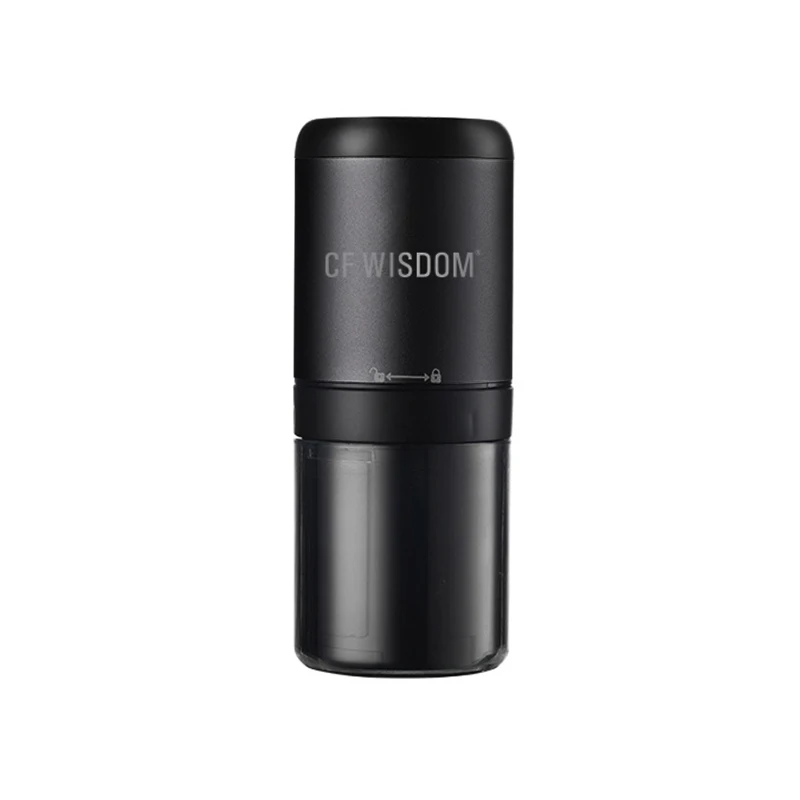
Capacity and Grinding Efficiency: Balancing Size with Functionality
The ideal capacity for a travel grinder balances efficiency with portability. Most quality travel coffee grinders hold between 15-60g (0.5-2oz) of beans—enough for 1-3 cups of coffee depending on your brewing method.
Grinding efficiency becomes particularly important when traveling. A well-designed manual grinder should produce enough grounds for a single cup (15-20g) in under 2 minutes with reasonable effort. This efficiency comes from the quality of the burrs and the mechanical advantage of the handle design.
For travelers, the single-dose approach often works best—grinding exactly what you need for each brewing session rather than grinding in batches. This preserves maximum freshness and eliminates the need for separate grounds storage.
Some innovative designs maximize the capacity-to-size ratio through tapered chambers or dual-purpose components, allowing for surprising capacity in compact packages.
Fine Adjustment Hand Grinder, Precision Manual Grinder, Travel Coffee Grinder
Price range: $185.11 through $494.63 Select options This product has multiple variants. The options may be chosen on the product pageHand Burr Grinder, Hand Crank Coffee Grinder, Manual Espresso Grinder, Portable Coffee Grinder
Price range: $262.72 through $300.22 Select options This product has multiple variants. The options may be chosen on the product pageManual Burr Mill, Manual Coffee Grinder Stainless Steel, Manual Coffee Mill Grinder, Mechanical Coffee Grinder
Price range: $127.26 through $130.32 Select options This product has multiple variants. The options may be chosen on the product pageHand Burr Grinder, Manual Coffee Grinder Stainless Steel, Precision Manual Grinder
Price range: $183.64 through $187.52 Select options This product has multiple variants. The options may be chosen on the product page
Maintenance and Cleaning: Keeping It Simple on the Go
Travel scenarios rarely offer ideal cleaning conditions, making maintenance simplicity a crucial feature for portable grinders. The best portable coffee grinders can be cleaned effectively with minimal resources—perhaps just a small brush and occasional dry cloth.
Look for designs that:
– Disassemble without tools
– Provide direct access to burr surfaces
– Have minimal crevices where grounds can accumulate
– Include a small cleaning brush (often stored within the grinder itself)
A simple field cleaning routine might include:
1. Disassembling the major components
2. Brushing visible coffee particles from burrs and chambers
3. Gentle tapping to remove trapped grounds
4. Wiping accessible surfaces with a dry cloth
5. Reassembling for next use
For longer trips, consider grinders with design features that minimize retention—the tendency for grounds to remain trapped in the grinder. Models with vertical burr alignment and direct-drop grinding paths typically offer the best performance in this regard.
Travel-Specific Convenience Features Worth Considering
Integrated Storage Solutions: Beyond Just Grinding
For travelers seeking to minimize the number of separate items in their luggage, integrated storage solutions offer significant advantages. Many premium compact coffee mills now include thoughtful storage features:
- Bean storage compartments built into the upper chamber or handle
- Precisely measured dosing capabilities that eliminate the need for separate scales
- Grounds collection cups that double as protective caps during transport
- Airtight seals that preserve bean freshness during extended travel
These multi-functional designs not only save space but also reduce the risk of forgetting essential components of your coffee kit. The best integrated systems provide enough capacity for a day’s worth of coffee (typically 30-60g of beans) while maintaining a streamlined profile.
When evaluating storage features, pay particular attention to the quality of seals—exposure to oxygen accelerates flavor degradation, making airtight storage particularly valuable during multi-day travel adventures.
Noise Considerations: Being a Good Travel Companion
Coffee grinders produce noise—an unavoidable consequence of breaking beans into smaller particles. However, the volume and quality of this noise vary significantly between models, a consideration that becomes particularly important when traveling with companions or staying in shared accommodations.
Quiet travel-friendly grinders typically feature:
– Dampening materials that absorb vibration
– Precision-machined components that reduce operational noise
– Secure connections that prevent rattling during grinding
Beyond grinder selection, consider these practical noise-reduction techniques for travel:
– Grinding in bathrooms where tiles and shower curtains absorb sound
– Placing a folded towel beneath the grinder to reduce vibration transfer
– Grinding in advance when possible, perhaps while travel companions are awake
– Communicating your coffee ritual with those sharing your accommodation
While no manual grinder is completely silent, the difference between a well-engineered model and a basic one can be significant—the former producing a smooth, consistent sound while the latter might create a jarring, variable noise that carries through walls.
How to Choose the Perfect Travel Coffee Grinder for Your Needs
Finding the ideal travel grinder requires matching features to your specific coffee habits and travel patterns. Start by honestly evaluating:
- Your brewing methods: Different methods require different grind consistency capabilities
- Typical travel duration: Longer trips might justify more durable, versatile equipment
- Travel style: Ultralight backpacking demands different solutions than business travel
- Brewing frequency: Daily rituals warrant higher quality than occasional use
- Available preparation space: Compact hotel bathrooms vs. spacious vacation rentals
For most travelers, feature priorities typically follow this hierarchy:
1. Portability (appropriate size/weight for your travel style)
2. Grind consistency (affects cup quality directly)
3. Durability (resistance to travel stresses)
4. Ease of cleaning (practical maintenance on the road)
5. Adjustment range (versatility for different brewing methods)
When comparing options within your budget range, remember that best hand grinders for travel brewing often represent a worthwhile investment. Unlike electronic devices that quickly become obsolete, a quality mechanical grinder can provide decades of service when properly maintained.
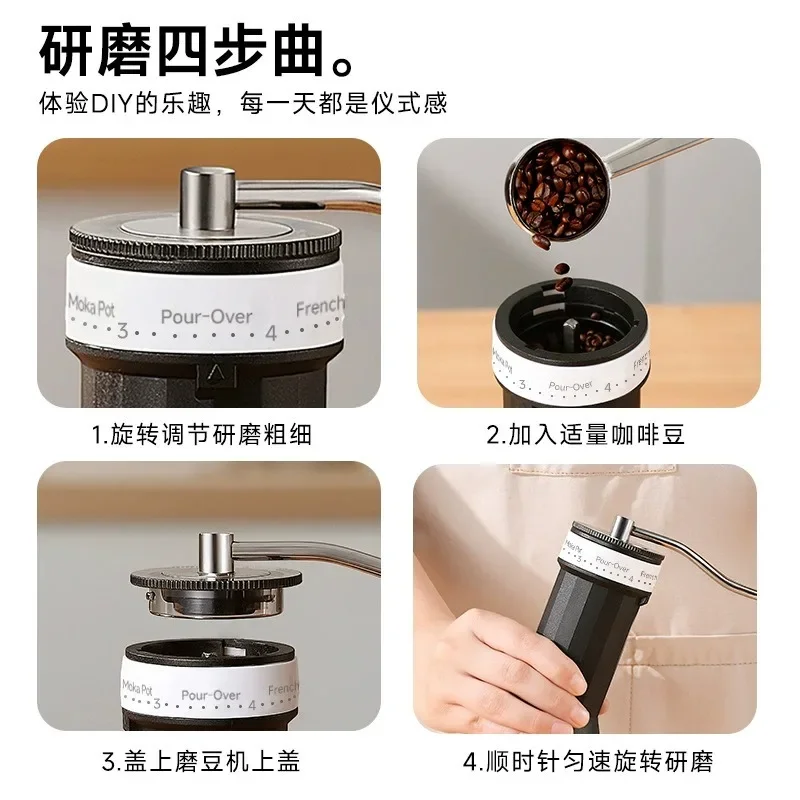
Supplemental Content
Can Travel Grinders Match Home Grinder Quality?
This question represents one of the most common concerns for coffee enthusiasts considering portable options. The encouraging answer is that premium travel grinders can indeed produce results comparable to quality home models, though with some nuanced differences.
Modern high-end portable grinders feature burr sets and alignment mechanisms that rival dedicated home equipment, particularly in the hand grinder category. Where compromises typically occur:
- Grinding speed (travel models often require more time)
- Capacity (smaller chambers mean more batches for multiple servings)
- Adjustment mechanisms (sometimes simplified for durability)
Recent design innovations have significantly narrowed the performance gap, with some benefits of manual coffee grinders actually providing advantages over their electric counterparts, including better heat management during grinding, which helps preserve volatile flavor compounds.
The most significant factor remains burr quality and alignment—premium portable models using precision-manufactured steel or ceramic burrs can produce particle consistency that matches or even exceeds entry-level home electric grinders.
How to Pack and Protect Your Coffee Grinder While Traveling
Proper packing technique helps maximize your grinder’s lifespan and prevents performance-affecting damage during transit:
For carry-on luggage:
– Place grinders in dedicated protective cases when available
– Otherwise, wrap in soft clothing items to prevent impacts
– Position away from heavy items that could cause pressure damage
– Consider removing handles or external components if designed for disassembly
For checked luggage:
– Always use protective cases or padded wrapping
– Place at the center of soft items, away from the case exterior
– Remove any loose components and store separately
– Consider partially disassembling precision grinders to reduce stress on bearings
Additional protection strategies include using silicone caps to prevent moisture intrusion and small silica gel packets to control humidity when traveling to tropical environments. These simple precautions help ensure your quality travel coffee mill remains in peak condition throughout your adventures.
FAQ: Common Questions About Travel Coffee Grinders
Can I bring a coffee grinder through airport security?
Manual coffee grinders are generally permitted in both carry-on and checked luggage. TSA and most international security agencies classify them as kitchen tools. Electric grinders with batteries should follow standard battery transportation guidelines.
How do I clean my grinder without running water?
Use a small brush to remove coffee particles, followed by a microfiber cloth for more thorough cleaning. Pre-moistened food-safe wipes can help with more stubborn residue. Complete disassembly and proper cleaning should wait until you have access to proper facilities.
What’s the best way to store coffee beans while traveling?
Airtight containers protected from light, heat, and moisture work best. Consider vacuum-sealed small portions for extended trips or specialized coffee storage containers with one-way valves that release CO2 without letting oxygen in.
How frequently should I clean my grinder during extended travel?
A quick brush-out after each use prevents flavor transfer and buildup. For trips longer than a week, aim for one more thorough cleaning to maintain optimal performance.
Travel Brewing Methods That Pair Perfectly with Portable Grinders
The full potential of your travel grinder is realized when paired with equally portable brewing methods that complement its capabilities. Understanding the best coffee brewing methods for travel helps you create a complete system that delivers exceptional coffee anywhere.
The AeroPress has become a favorite among travelers for its remarkable versatility, accepting various grind sizes from medium-fine to medium-coarse. Its compact size and rapid brewing make it ideal for hotel rooms or outdoor settings alike.
Collapsible pour-over drippers offer another excellent option, folding flat for transport while providing excellent extraction when paired with medium-grind coffee. Their simplicity and minimal weight make them perfect companions to quality hand grinders.
For those who prefer immersion brewing, the combination of a travel grinder with a French press travel mug creates an all-in-one solution that minimizes space requirements while maximizing flavor potential.
By thoughtfully selecting complementary brewing equipment that matches your grinder’s capabilities, you create a travel coffee kit that ensures quality and consistency, transforming any destination into your personal café. This comprehensive approach to mobile brewing helps maintain your coffee ritual—a comforting constant amid the wonderful variability of travel.


